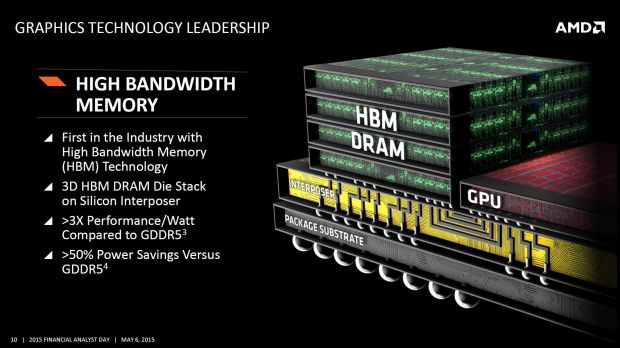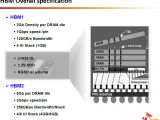While the first series of HBM stacked memory was a real technological breakthrough for AMD, its main temporary limits were memory capacity. However, a second-generation high bandwidth memory with increased capacity is rumored to hit the markets in 2016.
When the Radeon R9 Fury X came along this summer, the performance upgrades compared to the competitor's NVIDIA GTX 980Ti were visible. However, that visibility didn't come from the actual hardware available but from the potential that it could have had considering that Fury X came with 2 to 8GB of HBM memory less than NVIDIA's GTX 980Ti at 6GB GDDR5 and Titan X's 12GB GDDR5.
But the Fury X was just the beginning, as AMD is considering downsampling the HBM technology together with SK Hynix to create the first HBM GPUs made for laptops and notebooks.
Having the PCB area reduced thanks to the new memory stacking technology, AMD plans to impose the new technology where it has rarely succeeded, especially on the mobile application market, the idea being a very attractive proposition indeed. If the Fury trio succeeds financially and performance-wise, it will clearly start a new trend from AMD and mark a step further to a possible move towards the mobile market challenging the Nvidia and Qualcomm domination.
HBM was just the beginning
According to wccftech, AMD is already working on a new-generation HBM stacked memory architecture code-named Arctic Islands, carrying a new GPU code named Greenland. This new GPU is said to be on the new FinFET 14/16nm manufacturing process instead of the classical 28nm of all current-gen discrete GPUs from both NVIDIA and AMD. The new process manufacturing will increase transistor density, helping developers bring more powerful chips on the same form factor as today or even smaller.
Although there are currently supply issues with the new Fury X, AMD believes that together with SK Hynix this issue will be overcome by forcing the consumer market to switch to HBM technology in much larger numbers than before and leaving NVIDIA in the offside until it finishes researching its own future Pascal microarchitecture.
AMD does throw a lot of weight behind this move and it might very well succeed if NVIDIA comes too late to the party. Apparently, the only first generation of HBM technology belongs exclusively to AMD thanks to its co-development with SK Hynix; however, it's unknown whether SK Hynix will share the following HBM2 technology with other companies too or it will keep this exclusivity only with AMD.
Maxed-out 4K gaming is at hand
It's worth noting, though, that Pascal GPUs have already been taped out but without the HBM2 being fully developed, the new GPU from NVIDIA can't be completed. The only conclusion we can draw from this fierce competition is that only next year the 4K gaming will reach maturity, when graphics cards will be more than capable to deal with these sorts of exponential performance leapfrogs that the entertainment industry is currently going through.

 14 DAY TRIAL //
14 DAY TRIAL // 



